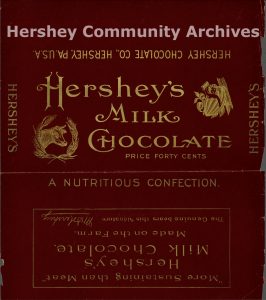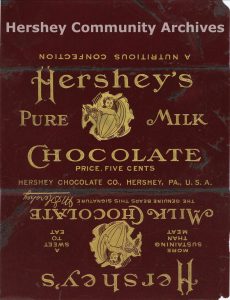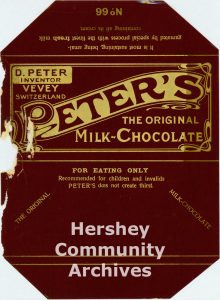HersheyArchives@30, Part 5: Maroon and Silver
The familiar Hershey’s Milk Chocolate bar wrapper.
The maroon and silver package, sometimes described as brown and silver, is identifiable at a glance. You can imagine the many versions and proofs Milton Hershey must have considered before settling on the now iconic wrapper design; the “face” of his new brand and his new product. Yet the process of designing the wrapper was not so straightforward. Within the Archives’ collections, documentation reveals a particular set of circumstances that transpired as to why maroon and silver came to symbolize the Hershey brand.
Milton Hershey, after years of experimentation, began marketing Hershey’s Milk Chocolate in 1900. The bar retailed for 5 cents and was wrapped in a white wrapper with gold lettering.
The wrapper featured Hershey’s two trademarks, a cow’s head enclosed in a wreath of wheat and the cocoa bean baby. The gold lettering was similar to that used on Hershey’s earlier semi-sweet or dark chocolate products. Hershey’s Milk Chocolate Bars were immediately successful and distributed nationally, but there was one problem. The white wrapper had a tendency to become soiled and stained during the summer months as heat influenced the product.
In 1902, Hershey instructed that a brown wrapper, printed with the same trademarks and lettering, should replace the problematic white wrapper. According to Milton Hershey, “The brown color of paper was selected by me for its wearing qualities, durability, cleanliness, and not being liable to soil.”[i]
In 1903, Hershey visited Ketterlinus Lithographic Manufacturing Company in Philadelphia, Pennsylvania and had an additional wrapper designed.
Hershey was not the only manufacturer of milk chocolate in the United States. He was however, the only manufacturer to use fresh milk; other manufacturers used milk powder or condensed milk. In 1905, the Societe Generale Suisse De Chocolats, manufacturers of Peter’s Chocolate, took notice of Hershey’s activities.
Peter’s argued that Hershey’s Milk Chocolate Bar wrapper was too similar to Peter’s Chocolate and caused consumer confusion and brought suit against Hershey. A judge agreed with Peter’s and ordered Hershey to discontinue use of the wrapper.
Hershey complied with the judge’s order and to differentiate his wrapper from that of Peter’s began using silver lettering in place of the gold.
Peter’s continued to protest Hershey’s use of the maroon, or brown, color citing that other manufacturers began to utilize the color as well causing market saturation.[ii] Milton Hershey was satisfied with the new wrapper design of maroon and silver and was not swayed by Peter’s arguments.
In one way, the familiar maroon and silver wrapper is the product of legal action. Perhaps though, Milton Hershey saw the change as an unexpected improvement. Had he not been satisfied with the new design he would have returned to the Ketterlinus offices. The experience had an additional positive impact on Milton Hershey. It introduced him to the value of intellectual property and trademarks in the development and protection of a brand. Hershey would recall this experience and use the lessons he learned in the future to protect his next product: Hershey’s Kisses Chocolates.
[i] Milton Hershey affidavit, 1905. Accession 200945, Box 1, Folder 42.
[ii] Correspondence, Frederick Duncan to John Snyder, January 21, 1908. Accession 200945, Box 1, Folder 41.



